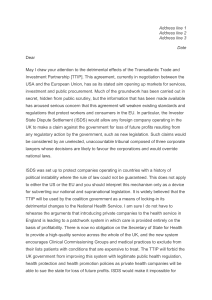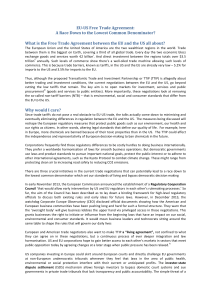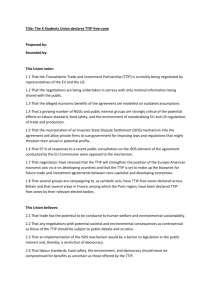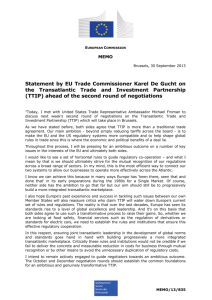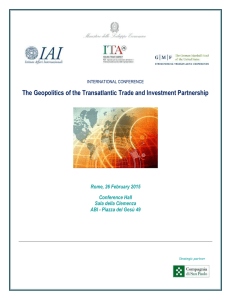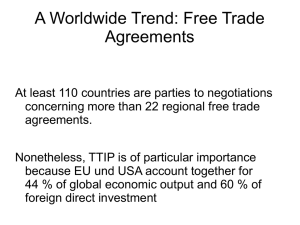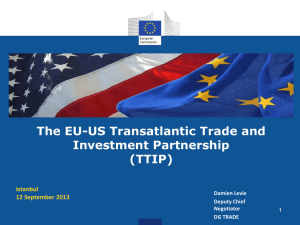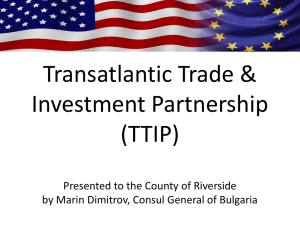A TTIP-ing Point for Europe in the World Issues at stake
advertisement
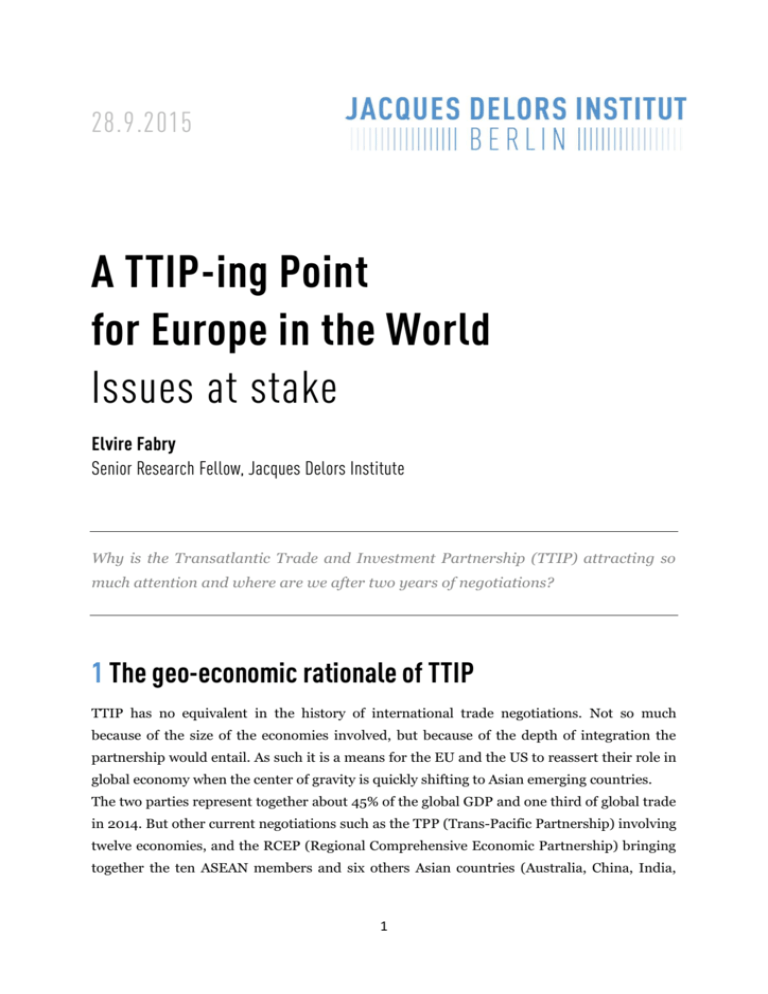
28.9.2015 A TTIP-ing Point for Europe in the World Issues at stake Elvire Fabry Senior Research Fellow, Jacques Delors Institute Why is the Transatlantic Trade and Investment Partnership (TTIP) attracting so much attention and where are we after two years of negotiations? 1 The geo-economic rationale of TTIP TTIP has no equivalent in the history of international trade negotiations. Not so much because of the size of the economies involved, but because of the depth of integration the partnership would entail. As such it is a means for the EU and the US to reassert their role in global economy when the center of gravity is quickly shifting to Asian emerging countries. The two parties represent together about 45% of the global GDP and one third of global trade in 2014. But other current negotiations such as the TPP (Trans-Pacific Partnership) involving twelve economies, and the RCEP (Regional Comprehensive Economic Partnership) bringing together the ten ASEAN members and six others Asian countries (Australia, China, India, 1 Japan, New Zealand and South Korea), also represent a very large share of global GDP and trade (respectively nearly 36% and 25% for the TPP, and 29% and 28% for the RCEP). What distinguishes TTIP from the TPP and the RCEP is its broad scope of negotiations. The US and EU economies are already deeply integrated and the negotiations intend to go far beyond traditional issues like tariff reduction and market opening, which are the primary focus of the TPP and RCEP. The purpose of TTIP is to set up a pioneering mechanism to address the main challenges facing commercial agreements in the 21st century: regulatory incompatibilities. Reducing the heavy cost of differences in technical regulations, standards, and conformity assessment procedures via a process of mutual recognition when there is an equivalent level of precaution will allow the export-minded producers to achieve significant economies of scale. These gains will be much higher than a further reduction of tariffs between the EU and US because they are already very low. It will also reinforce the capacity of the transatlantic community to set international norms at a time when several emerging economies – not least among them China – are developing their own norm-setting ambitions. Regulatory cooperation in TPP and RCEP is limited by economic diversity of countries involved and existing discrepancies between levels of precaution in technical standards. By contrast, the EU and the US have more values in common than with the rest of the world and therefore a more similar approach to precaution. In addition to this geo-economic rationale, the geopolitical dimension of the project, which aims at bringing closer two historical allies, has been reinforced by the confrontation with Russia in Ukraine. The EU’s push to import substantial volumes of US LNG will reduce dependency on Russian energy supply. But it requires first a freer trade with the US. Yet this process of convergence will be difficult. Neither the US nor the EU has been confronted to such a major trade actor in previous trade negotiations and two years of talks have shown that it is arm wrestling. 2 A long complex process Thus far, ten negotiating rounds have taken place. But TTIP negotiators continue to explore what is desirable and what is feasible without being in a position to deliver significant progress that would alleviate public worries about this very new kind of negotiation. Talks on 2 public procurement have not started. It is not yet clear how far both the EU and the US are willing to open their service markets to each other. Even on the issue of tariff reduction, which is considered the easiest topic, Europeans are still waiting for the US second counter offer. Trade negotiations are long processes. The CETA negotiation between the EU and Canada lasted five years, while the TPP negotiation was launched in 2006 before the US joined the talks in 2010. And there is no trade negotiation – bilateral, regional or multilateral – in which the parties put their best offer on the table before they have an overview of all negotiating chapters. Red lines imposed within the negotiation (e.g. protection of public services, unchanged bans on imports of certain goods) became a substitute to full transparency, which was impossible beyond the publication of the European Commission’s negotiating positions. Yet 2015 was marked by strong mistrust from the European public, notably in Germany where critics of TTIP where the strongest in the EU despite a recent poll showing a slight increase in favor of the negotiation1. Opponents focus on two fears: first, that TTIP could lead to a race to the bottom in standards. Producers would win, but workers and consumers lose out. Second, the inclusion of an investor state dispute settlement (ISDS) mechanism would interfere with the sovereign competence of states to regulate. By contrast to tariffs, the complexity of regulatory cooperation is more intimately linked to values and collective preferences; and, on both sides of the Atlantic, consumers tend to believe that the level of precaution is higher on their side and is likely to be lowered by any regulatory cooperation. However regulatory cooperation is not a negotiation. There cannot be any trade-off between standards. It can only be about implementing either harmonisation or a mutual recognition process when there is an equivalent of level of precaution between two standards, despite a different administration of precaution. It will thus be in the hands of regulators – not of the negotiators who will only set the horizontal rules of the process - to assess the level of 1 The July 2015 TNS Emnid Opinion poll revealed that 42 % of Germans believe TTIP is “a good thing for Germany”, against 39 % in the previous poll in February 2015. 3 equivalence allowing for convergence, sector by sector and norm by norm. Regulatory cooperation will therefore be a long lasting process even after a TTIP agreement is signed. There are however sensitive questions that need to be addressed. What will be the sequencing of this regulatory cooperation? How public opinion will be able to assess how far it has been pushed in each sector? And how negative distributional effect will be managed? The inclusion of an ISDS mechanism is seen as another heavy stumbling block in the negotiation. Continuous pressure coming from civil society representatives, members of the European Parliament, and the Franco-German proposal - to create a permanent court for investment - have contributed to making some progress in the European debate about improvements or alternatives to an ISDS mechanism. Cécilia Malmström’s recent proposal to create an investment court system has the potential to circumvent the gridlock, if it manages to find a positive echo from the US side. Many commentators anticipated a serious risk of stalemate in the negotiation with the US negotiators’ attention focused on the conclusion of the TPP and a lack of political support on the European side. However, Congress’s recent vote on the “Trade Promotion Authority" (TPA), which gives the president the authority to negotiate international agreements, added to the adoption of a European Parliament resolution broadly supportive of TTIP brought new momentum to the negotiation. Malmström’s proposal on investment, meanwhile, could further put wind in the sails. However, new questions are raised with the willingness of the Heads of State to accelerate talks to conclude an agreement by mid-2016 in order to avoid heavy delays with the upcoming heavy electoral agenda (US Presidential elections in November 2016, presidential elections in France in May 2017 and legislative elections in Germany in October 2017). Given the complexity of the process, is it purely unrealistic or even counterproductive to call for a quick ending of the negotiations, especially given the public’s opposition to having a quick deal signed behind their back? Or does it mean that the scope of the negotiation could be meaningfully reduced? What could be the modalities of a “living agreement” allowing to grasp the low hanging fruit and to bring the negotiations further? 4 Last publications of the Jacques Delors Institute on the same theme: - France: A hotbed of opposition to the TTIP?, Elvire Fabry, June 2015 - TTIP and third states, Elvire Fabry and Emmett Strickland, June 2015 - ISDS in TTIP: the devil is in the details, Elvire Fabry and Giorgio Garbasso, January 2015 - The reality of precaution: comparative analysis EU - USA, Elvire Fabry and Giorgio Garbasso, July 2014 - The TTIP at the forefront of the 21st century international trade system?, Elvire Fabry, March 2014 - The TTIP negotiations: A Pirandello play, Elvire Fabry, Giorgio Garbasso and Romain Pardo, January 2014 Herausgeber: Prof. Dr. Henrik Enderlein. Die Publikation gibt ausschließlich die persönliche Auffassung der Autoren wieder. Alle Rechte vorbehalten. Nachdruck und sonstige Verbreitung – auch auszugsweise – nur mit Quellen-angabe zulässig. Originalfassung © Jacques Delors Institut – Berlin, 2015. Pariser Platz 6 D-10117 Berlin office@delorsinstitut.de www.delorsinstitut.de T +49 (0)30 467 26 095 - 01

